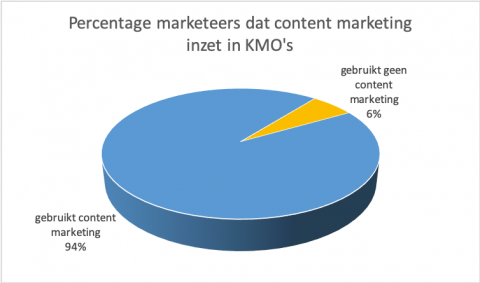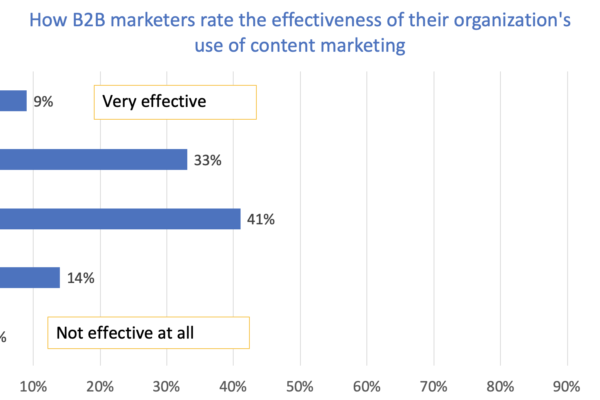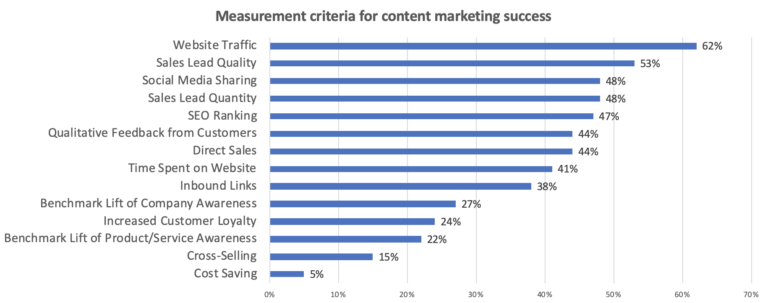8 Reasons Why Your Content Marketing Isn’t Working
Is your content marketing not producing the results you hoped for? It’s a common problem. A lot of organizations try their best to use content marketing to attract more visitors or generate leads. They try their best, yet they fail. And the worst part is: they don’t know why their content marketing isn’t working for them.
94% of companies worldwide are putting effort into content marketing. And most of them fail to get results out of it.


Only 9% of them claim to be using content marketing efficiently, according to Content Marketing Institute.


A lot of companies that contact us are in that situation. They create and post content, but they don’t get any return. And there is a good reason for that. In this blog post, we’ll share 8 reasons why your content marketing isn’t working.
Content marketing without a strategy
To us it’s obvious: you need a strategy. But you’d be amazed at how many organizations don’t bother with a strategy at all. It’s like trying to win the war just randomly marching wherever you like and shooting around you: it will get you nowhere. the same goes for content marketing: no results without a strategy.
A content marketing strategy takes time and energy, but it WILL deliver results. Are you unsure on how to get started? Take a look at what other companies are doing, and adopt what you think will work for you. Also, look at your competitors and learn from them. Just don’t copy paste.
If you don’t have the necessary time or skills, then get someone from your company or an external specialist to take care of this. No matter how you do it, just make sure you have a strategy. The same studies by Content Marketing Institute show that the majority of companies that successfully use content marketing have a documented strategy.
No customer-centric thinking
Another common reason companies fail at content marketing is ignoring the customer. A lot of companies forget to do research and don’t use any feedback they get from existing customers.
It is a lot easier to start from your own point of view. Too many companies start from their own product or service, or their idea about an industry, and then use that thinking when they talk to potential customers. The problem with this is: if your content is not aligned with what your customer wants, it is difficult to really connect with them. Let’s say your lead is looking for an ecologically responsible car, but you are focusing on the fine leather interior or amazing horse power. If your ideal customer isn’t looking for the things you are focusing on, they will never buy from you.
I can’t emphasize it enough: it’s really important to know what your clients want. By working with buyer personas you can map that out. Once you have a good understanding, you can start thinking from your customer’s perspective, and you can align your content to what they want.
Just copying others
Of course, you can look at how your competitors are doing. That’s called market research, and everyone does it. To know what your competitors are doing is valuable information. For example, you can take a look at your competitor’s website or social media channels, or get their brochure.
But just copying what they are doing is a bad idea. Even if you have a similar product or service, your organization is set up differently. Chances are you will need a different marketing approach. If your research shows that you should start doing the same thing as your competition, then maybe you should. But the odds of that happening are about as much as winning the national lottery.
Your customers choose you as a supplier for a specific reason, and that reason is usually different from your competition. Figure that out and use it to publish unique content that will draw in the right leads.
Unrealistic expectations
Too often we hear people say that they expect their content to go viral. It can definitely happen, but it’s rare. Expecting your content to go viral is just not realistic. Try not to be tempted to set unrealistic expectations. In the end, you will lose your motivation to focus on content marketing and that would be a shame, right?
Instead, set some goals that are realistic and within your budget. Have a look at things like:
- The number of visitors to your website
- Brand awareness
- Lead generation
- Engagement
- Customer retention
- Number of sales
- Number of followers
- etc.
Make your goal ambitious, but be realistic and make it relevant for your organization. If you own a restaurant, your goal may not be to have half a million followers on your Facebook page.
Lack of content distribution
Some organizations put a lot of effort into content creation. Even though their content is good, its distribution is often the problem. And that’s a shame: what good does your content do if nobody ever sees it? Creating content without promoting it to your target audience is just as effective as not publishing any content at all.
So please don’t make that mistake. Spend some time distributing your content through different channels, including social media and email marketing. Since you do have a strategy in the meantime (right?), you have documented which channels are important. Content can never be successful if there’s no interaction. The key here is to be consistent. It doesn’t make sense to post something every day for a month and then nothing for 3 months.
No attention to quality
If you are planning to use content marketing, then you might as well do it the right way. Boring content will not bring in any results. And incorrect of irrelevant content does more damage than good.
Yes, it’s possible to create fun content for any industry. We posted an article on content marketing for ‘boring’ industries.
Make sure that first of all, your content is relevant to your target audience. Make your approach to the topic unique. By doing so, you will attract visitors and convince them to read your content.
It doesn’t stop here. If your content is full of grammar or spelling errors, or your text is too small to read, your content will not be successful. Make sure you have enough white space and a font that makes it easy to read. And before publishing your content, have someone proofread it. That person can give you valuable feedback, allowing you to adjust and improve your content.
The wrong audience
I can’t stress it enough: you need to know who your ideal customer is. Too many organisations are making content for people who aren’t interested. Even with the right tone of voice, the wrong audience is just never going to give a damn about your content.
So make sure you know what questions they are asking and what their needs are. Your content should answer those questions. If you don’t know, it’s impossible to align your content to your target audience.
What audience do you want to reach, through which channels? And how do they communicate with you and your organization? If you have no idea about that, it can be very hard to reach the right people.To get this right, you can use buyer personas.
Ignoring your analytics
I completely understand: analytics is not your favorite part of your job. That’s the case for most marketing professionals. But I would do it anyway. You can only be successful if you measure whether your efforts are effective or not.
By analyzing your data, you learn a lot about your target audience, how your campaigns are performing and what content is or isn’t popular. If you don’t do anything with these, your content will never reach its full potential.

Make sure you include enough metrics in your analysis. The number of unique visitors is very important, but it should certainly not be the only thing you look at. Don’t forget to include other interesting metrics of your website, social media and email marketing campaigns. You can get a lot out of them as well. It’s up to you to decide which metrics matter to you.
Once you have a good idea of all the relevant metrics, you can measure your success. Then you’ll also be able to make adjustments where needed.
As you can see, there are quite some things you can do wrong when you start with content marketing. Fortunately, it’s also pretty easy to fix. Keep in mind that content marketing is more than just publishing blogposts. You need a strategy and you should definitely spend enough time on promotion. Be patient, learn and adjust as you go along. With time an effort, you’ll definitely start seeing the results of all your hard work. If you want to know more, don’t hesitate to book a free consultation with us!
Perfect your content marketing strategy
Download our free whitepaper and build your ideal content marketing strategy with our tried and tested tips & tricks.






